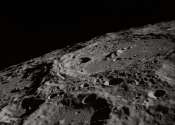Early moon model shows heavy metal atmosphere
(Phys.org)—A team of researchers working at NASA's Goddard Space Flight Center has developed a model meant to show what the early moon may have looked like. As they note in their paper uploaded to the arXiv preprint server, ...









